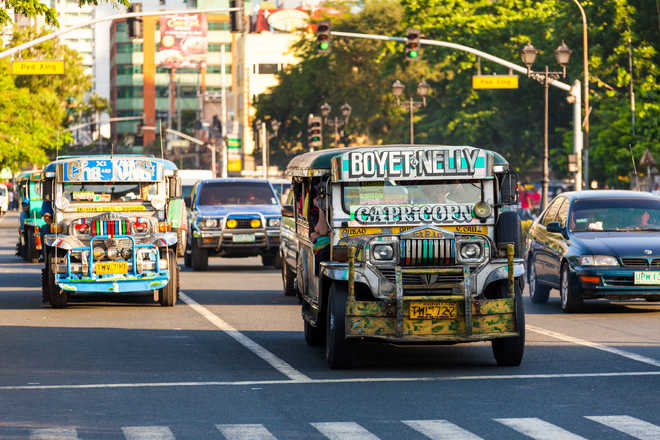
Manila, Philippines - April 19, 2012: Colourful Jeepney vehicle makes its way through traffic in Metro Manila in the morning.
Preeti Verma Lal
Is it a jeep? Is it a taxicab? Is it a jitney? Is it a mural? Or just a jeep turned into a quirky art canvas? And what do you call it? A dyipni? A jeepney? What is its age? First generation? Second generation, or third? In the Philippines, a four-wheeler packed with people can intrigue the visitor. They are everywhere, packed with people using it as the fastest, quickest and cheapest mode of transport.
So packed are these jeepneys that if you get an inch inside, consider it a feat. No one confirms, but gossip is that the name jeepney is a portmanteau of jeep+knee. The passengers sit so close to each other that they knock knees. Hence the name.
Jeepneys are, but, a smart Alec’s idea. At the end of World War II, when American troops were leaving the Philippines, hundreds of surplus jeeps used in the war were sold or given away to the Filipinos. Then, Harry Stonehill, an American soldier, gave the Willys a makeover. Metal roofs were added to the open jeeps, the bodies painted in flaming red, canary yellows, blast pinks. Chrome-plated ornaments were welded for bling and two long parallel benches were squeezed into the Willys’ back. And lo! the old war horses were metamorphosed into public carriers. Soon, the jeepneys gained immense popularity and became everyone’s favourite mode of transport.
So integral are jeepneys to Filipino culture that each region has its own kind. In the central island of Cebu, flat-nosed jeepneys are made of second-hand Japanese Isuzu Elf and Suzuki trucks. In Iloilo, they are sedan-converts and called ‘passad’. With front grille, chrome wheels, tubeless tires and industrial-quality paint jobs, Davao City jeepneys stray from tradition and call themselves ‘uso-uso’. In Baguio City and Benguet province and areas with unpaved roads, jeepneys come with monster truck tyres. The most flamboyant and the noisiest jeepneys are in Makati city while Manila Metro area is beginning to embrace e-jeepneys (electric jeepneys).
What makes the jeepneys a sight to behold is how arty they are — flowers painted on one, cartoons on another, pithy saying emblazoned across the chest, a star on the bonnet or just large fonts announcing the owner’s name to the world. They are boisterous gas guzzlers too. They cut routes, pack people like sardines and do not be surprised if you find a jeepney picking a passenger from the middle of a busy lane. Not surprisingly, a bus driver from London had a nightmarish experience on the BBC television program, The Toughest Place to be a Bus Driver. The poor driver drove a jeepney in the chaotic streets of Manila. He survived. Luckily.
On the streets of Manila, one can also pick the Jeepney magazine. Except the name on the cover, there is nothing about jeepneys within its pages. But in the Philippines, there is no escape from the jeepney. On the streets. And in its history.



























